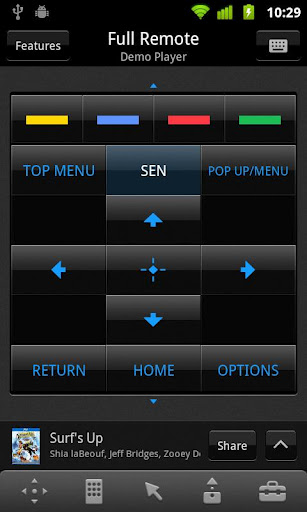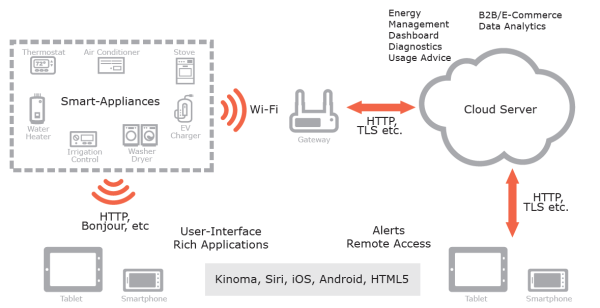Home Automation and the 'Internet of Things'
by Ganesh T S on October 4, 2012 10:30 AM EST- Posted in
- Gadgets
- Home Automation
- Wi-Fi
Technologies such as ZigBee came up in part due to the unsuitability of Wi-Fi, Bluetooth and other such technologies to provide networking with low power consumption, low cost, simplicity and the ability to remain in a suspended state for extended periods of time. Most of the HA technologies were developed when Wi-Fi was unable to satisfy all of these criteria. However, over the last few years, Wi-Fi has slowly, but surely, gained a significant foothold in the home automation industry.
The rise of Wi-Fi's role in home automation has primarily come about due to two factors
- Networked nature of today's electronics: Commonly used electronic devices such as televisions and AV receivers have started becoming part of the home IP network. Even though the networking aspects were added to bring in support for online streaming services or network playback, it became an easy value-add for the manufacturers to expose control of the device functionality over the network.
- Rise of mobile computing devices: The increasing rate of adoption of smartphones and tablets was an added boon. These devices ensure that consumers have access to a portable 'controller' for the electronics connected to the network.
Before proceeding further, I will take a small detour to talk about my personal experience with home automation. Like any other long-time renter, I had no interest in investing money towards fancy home automation solutions. However, as a reviewer of HTPCs and media streamers, I had often used the streamers' Android remotes / XBMC web & Android remote for playback control using my smartphone. I had also installed Sony's remote for my KDL46EX720 TV on my Android smartphone, but rarely got the chance to use it. I realized the full benefit of the Android remote when I found that I could switch on / mute or reduce the volume on the TV without being in the same room.

Sony's Android Remote: Whetting the Appetite for Home Automation
In scenarios such as those outlined above, consumers don't realize that they are actually using some form of HA. The Wi-Fi network already fulfills the basic requirements of a HA system without any extra expenditure on the part of the consumer. For any technology to succeed amongst consumers, price is key. Wi-Fi practically turns out to be free for HA purposes. Hence, it will not be a surprise if home automation with Wi-Fi finally manages to catch the attention of consumers in a way that current technologies haven't been able to.
Addressing Wi-Fi’s Naysayers
We have been through multiple generations of Wi-Fi since the first 802.11-based consumer products appeared in 1999. With maturing technology, the cost of Wi-Fi radios has gone down. They have also become simpler to integrate into systems. At the beginning of this section, we had outlined the reasons as to why ZigBee was developed as an alternative to Wi-Fi for HA purposes. We see that some of these issues have already been addressed. Power consumption and reliable range, however, remain a problem. Towards this, the 802.11 group is working on a new standard, 802.11ah. Expected to be ratified around May 2015, its main purpose is the creation of a sub-1 GHz sensor network. Smart metering is one of the intended applications, but home automation should not be far behind. 802.11ah should help address any shortcomings of current generation Wi-Fi for HA purposes.
Silicon Vendors Target Fast-Growing Market
The primary requirements for the wireless communication modules in these HA devices are:
- Low power MCU integrated in the module along with networking stack
- 802.11 b/g support (802.11n is not strictly necessary)
- Small form factor and full industrial temperature range (-40C to 85C)
- Small host footprint in terms of Flash and RAM requirements
We have a number of Wi-Fi radio makers targeting this embedded Wi-Fi market. TI has the CC3000, launched in January 2012, which is part of LSR’s TiWi-SL self-contained Wi-Fi module. Marvell also launched the 88MC200 microcontroller in January 2012. It is tied along with the Marvell Avastar 88W878x Wi-Fi radio SoCs for smart energy platforms.
Marvell's Pitch to Customers Integrating Wi-Fi in Smart Appliances (The concept remains the same with Wi-Fi modules from other vendors too)
Qualcomm Atheros launched the AR4100P Wi-Fi System-in-Package for the home automation market in March 2012. The AR4100P is a 802.11n single stream Wi-Fi system-in-package with an integrated IPv4/IPv6 TCP/IP stack. Board vendors such as RTX deliver pre-built cards based on the AR4100P along with software support.
If WiFi has to replace specialized HA protocols in simple switch type devices, it has to offer a significant cost advantage at installation. Obviously, support for more than 256 nodes has to also be provided seamlessly in a user friendly manner. Current HA controllers already integrate a hybrid of technologies using different standards where it makes sense (W-iFi + Z-Wave, Insteon or Zigbee). This will be a continuing trend till 802.11ah gains consumer acceptance and everyone realizes that specialized protocols serve no purpose. However, this is quite some time off and it is a concern only for people who have already invested in a HA standard. People starting to explore home automation options simply can't go wrong by choosing a pure Wi-Fi based one.
In this section, we saw control of the media center as one of the HA examples using Wi-Fi. Conventional HA systems include control of power switching, lighting, HVACs and home security systems. In the next few sections, we will take a look at some of the interesting Wi-Fi based HA devices.











54 Comments
View All Comments
AshuJoshi - Thursday, October 4, 2012 - link
Hi Ganesh,Very extensive article and well covered. A few thoughts, and I think you or your readers have already touched upon this:
1. Bluetooth LE / 4.0 - is pretty important as well. One because many medical devices have adopted BT, and not Zigbee or ZWave or WiFi.
2. ZWave is very popular BUT my concern is that it is controlled by one company.
3. SEP 2.0 is going to be a very important move forward especially because it will work with WiFi, HPAV, and Zigbee.
4. Kickstarter - I noticed that you picked some projects. I think there are three segments to Home Automation - DIY, Luxury and NOW Managed (as provided by the likes of Comcast). Luxury traditionally belonged to the likes of Creston but Control4 is playing a major disruptor now. For the DIY segment - Kickstarter has changed the world. Here is my post on the # of projects on Kickstarter for HA - http://bit.ly/Q02Mk2
5. Service Providers are getting very active in this space - Comcast, Rogers, AT&T, DT etc.
AshuJoshi - Thursday, October 4, 2012 - link
WiFi appears to be a popular choice for powered appliances and as the article talks about Semiconductor providers such as Marvell are providing compelling solutions. The challenge is that every implementation especially if it is from a different semi partner - its implementation in SW is different. That is there is no standard or specification to discover devices on WiFi - each implementation could be different. I am contrasting this with Zigbee because Zigbee has a well-defined protocol on how devices are discovered and controlled by category (Zigbee has its own terminology for all of this).davegravy - Friday, October 5, 2012 - link
Lots of talk about hardware, and a bit of discussion about controllers and host software, but there isn't a lot of software out there that's provides a bridge between all the different protocols and the central brain/logic essential to the smart home.I've been using LinuxMCE (free, open-source) and have been following their development for the past while. Not yet for the technically faint of heart, but there ARE device templates for a large number of different protocols (Z-wave, Insteon, KNX, RS232, IR, X10, various ethernet devices, etc) allowing you to control pretty much any type of HA device. It also controls media and VOIP telecom in your house. The end result is a fully integrated solution between all devices in your home.
Example: Someone rings the door bell. Your porch light turns on (if it is after sundown), your IP cam turns on, its video feed is forwarded to your mobile phone, and (if it knows you are home because your security system is not armed, or by other logic) to the various TVs around your house after powering them on. The video is also recorded to your server. If you were watching TV during this event, it pauses your feed and to show you the front door IP cam.
The possibilities are truly endless with this software, and I have to give it a plug here.
ntspam - Friday, October 5, 2012 - link
I was really hoping that google putting its software creating talent behind home automation was finally going to kick this market mainstream. What a disappointment.jed22281 - Sunday, October 7, 2012 - link
These guys have been ahead of the curve in this area for 4yrs+ now:http://openremote.org/display/HOME/OpenRemote
Truly open, ubiquitous, Home Automation solutions, shame they didn't get a mention.
taltamir - Sunday, October 7, 2012 - link
WiFi controlled lights, thermostat, and power... now your home can be hacked in ways that holliwood only dreamed of.geraldt - Friday, October 12, 2012 - link
Nice article on one of my obsessions. I so want WiFi to be the household communications protocol (actually TcpIp with any mix of wireless, wired CAT5, powerline Ethernet etc. that may be appropriate depending on the devices and controllers).I want a ubiquitous open standard that is well understood. I want two-way comm. I want sufficient bandwidth for video. I want security. I want all my current and future smart devices (desktop, tablet, smart phone, Raspberry Pi, robots, etc.) to be able to participate. I want that common infrastructure so I can incrementally add devices from various manufacturers. I also want the option of writing my own code in smart controllers e.g. PC.
One point the article kind of makes is that common comm protocol is not enough, you need a higher level API for each device that is well documented.
p.s. I think the technology in the new Kindle Paperwhite (touch, front lit, very low power, wifi) could be packaged into a great HA and AV remote. No video is a drawback for some applications like answering the door but still pictures at 1 fps might be fine.
xSaintSinnerx - Wednesday, November 7, 2012 - link
Maybe I'm mistaken but few years ago Microsoft was talking about getting involved in HA business. I believe Gates was talking about it too. MS could easily create standard for HA Wi-Fi and become leader on the market with hardware and software in Windows RT or 8 environment.can you imagine possibilities ... BSoD on your thermostat.
Nomzam - Thursday, November 8, 2012 - link
Yeah the idea and performance are best but there is a security risk of internet.<a href="http://www.squidoo.com/iport-launchport-inductive-... Automation</a>
space31 - Wednesday, August 7, 2013 - link
Some new web remonte power hère : http://www.wifipower.fr